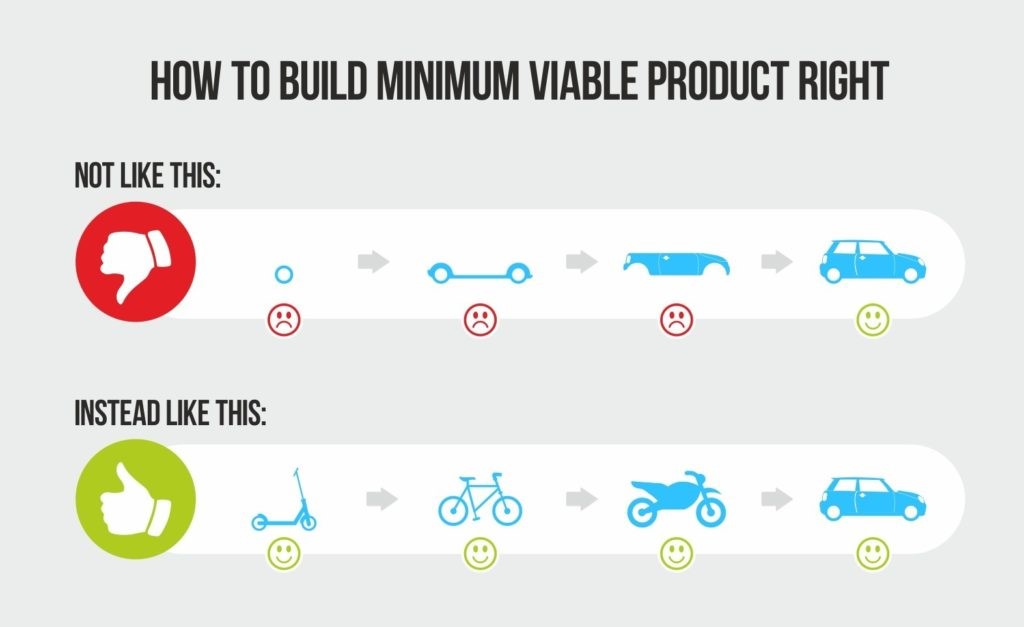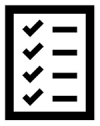Learning Objectives
By the end of this module, you should be able to:
- Understand the different types of MVPs and their function
- Build an MVP for your startup
At this point, you have spent some time developing an idea. You have a first iteration of a BMC and Value proposition canvas. Based on those customers, you have estimated a market size, and have come ideas on how you can stand out from your competitors. At this point, these are all assumptions! Generally speaking, these assumptions can fit into three broad categories:
- Assumptions that the product solves a problem, and solves it in an effective way.
- Assumptions that the problem is important enough for people to pay for a solution.
- Assumptions that you solve that problem more effectively than your competitors.
To validate our assumptions, we must test them by talking to customers and/or exposing them to the idea in a way that clearly communicates the value proposition through the least expensive way possible. This allows us to also test our riskiest and most uncertain assumptions (this process has also been called the Riskiest Assumption Test) before spending our limited resources. Showing a product is a better way to test these assumptions than simply describing the product.
The MVP is “[a] version of a new product which allows a team to collect the maximum amount of validated learning about customers with the least effort.” – Eric Ries
The MVP must also display only the core jobs/pains/gains that you hope to address, and test your riskiest assumptions first. The image below helps address these points. In the top diagram, the first step is only a wheel, and does not help the customer complete their job – to have faster transportation. We cannot learn anything from simply designing a wheel for the customer, since it is not valuable for them. The customer also does not know what the end-product will look like, so they are not potentially pleased until they see the complete car.
The image below has created an MVP for customers that helps solve their need for transportation (and you might even sell a few scooters)! The customer is happy as they do not know about the car at the end of that development diagram. They can also give feedback on how well the scooter solves their problem and what can be improved. We can learn how to improve the scooter early in the process, we can make money selling products along the way, and we have not had to spend a bunch of money to do it!

There are several types of MVPs, and we will discuss four of them.
- Landing Page (Smokescreen): These products simply focus on creating an engaging landing page that portrays your value proposition. It also features an action that you would like the customer to complete (like sign up for a newsletter, pre-purchase the product etc.) The goal of these MVPs is to develop and drive traffic to the page and measure the conversion pf visiting customers to those who complete that intended action.
- Explainer Video: create a video to describe what the product intends to do. One of the most famous examples is the explainer video for Dropbox.
- Flintstone MVP (prototype): This This is a low-cost way of building a product that doesn’t function using the means intended. Picture the car that the Flintstones used. It looks like a car, but is only powered by individuals running underneath the car with their feet. These MVPs might look like they do their jobs on the outside, but are operated manually on the inside. An example is with Zappos, one of the first online retailers. Although customers ordered shoes online through an e-commerce store, the entrepreneurs used to go to the mall and purchase the individual shoes to send to the customers. A prototype might also be a more classic product that is only considered a “rough draft” of the final product.
- Concierge MVP: This MVP tests whether a need exists and does not focus on the best product to meet that need. It is a manual-based non-scalable version of the product, and may not even involve a product itself.

Jason is the owner of Juniper Barbeque Scraper, which has a production facility in Deer Lake, Newfoundland. It sells barbeque scrapers and other local products made from natural, clean, tamarack wood. These scrapers are safer and cleaner than classic wire brushes. One day Jason posted an image on Facebook of a wedge-like scraper that he fashioned with some scrap wood he had around the house. On his post he asked if anyone would be interested in buying his product – (a prototype MVP). After receiving significant positive response, he got to work on making more, and a new local startup was well underway!
Now we will look at how you can develop your own MVP. Start by considering what kind of MVP might fit better with your own startup idea a your own skillset. It may be helpful to consider what kind of product that you have in order to make this choice.
For example, if you have an online retailer, you might use a landing page MVP or Flintstone MVP. A tour may have a landing page MVP so that customers can pre-book a tour. If you are making a physical product, then a classic prototype might be the best approach. Software or apps often lend themselves to explainer videos.
Building an MVP takes creativity and some planning. To explain this process, we will rely on Y Combinator CEO Michael Seibo:
Below we will look at some resources in western Newfoundland that can help you develop an MVP.
Resource
Possible Use
Grenfell Campus Fab shop and/or makerspace
Design and build a physical prototype using CNC machines, laser engravers, and 3D printers.
Shopify
Create an e-commerce site with little money or programming experience.
Wix / Squarespace
Create a landing page with little programming experience.
Biteable
Make an explainer video or stock advertisement video.
Facebook or other event-based social media
Post a tour or event and get pre-orders.
Sketchup
Make a 3D model of your product to show customers and/or print a 3D version.
Floorplanner.com
Create a floorplan for a brick-and-mortar store or restaurant.
As a way to plan for your MVP, create the following goals for yourself
- Outline a single action that you want customers to accomplish.
- Plan what features could be added to help make it more efficient/pleasant for the customer.
- Serve at least one specific audience
- Address at least one key problem
- Figure out how to measure the “success”

- Build an MVP for your startup idea.
- Bring this MVP to two people to get their feedback. See if they can describe your value proposition to you by only looking at your MVP. What other feedback can they give you? Do they seem excited or interested in the product? Why or why not?

